This Statement of intent (SoI) sets out an approach and course of action for the next three years that will contribute to the delivery of the government's land transport objectives and wider transport vision. It includes performance measures and what is intended to be measured (and how) and details of what is expected to be accomplished. The document also includes full financial statements. The SoI is a statutory compliance document.
Download the complete report:
NZ Transport Agency Statement of intent 2013–2016 [PDF, 1.5 MB]
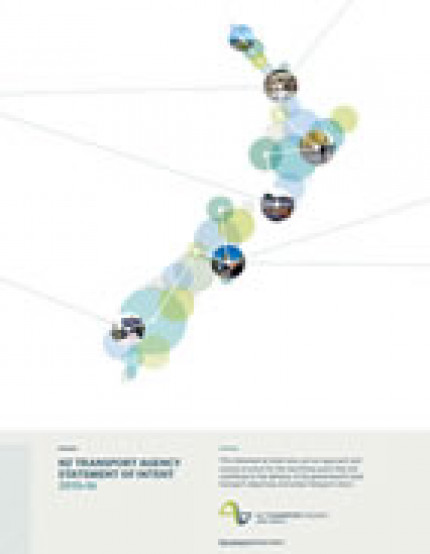
| Previous page | Table of contents | Next page |
Our long and short-term operating intentions give effect to the government’s direction for the transport sector.
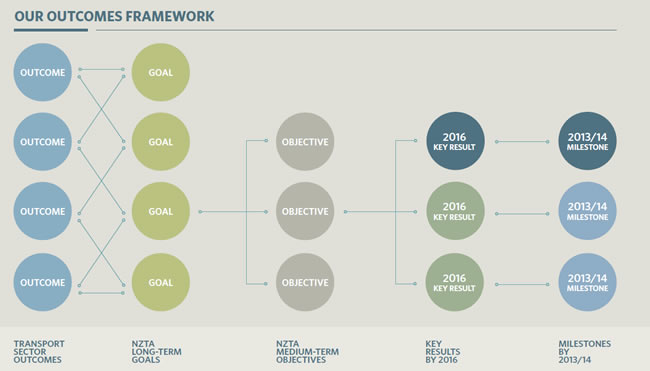 View larger version (JPG, 114 KB)
View larger version (JPG, 114 KB)
These describe the desired future state for the transport sector.
NZTA contributes to the realisation of the enduring outcomes by pursuing four long-term goals. The goals shape the organisation's direction and actions over the next 20 years. Indicators track our progress against each goal.
For each goal there are three medium-term objectives. These objectives have a 10 year outlook and guide our 10 year work programme.
For each objective there are between 1 and 8 key results for the NZTA to deliver by 2016. Some of the results may be prioritised – there are five clusters of priority results that relate to a specific goal success indicator.
For each key result there are specific milestones to achieve in 2013/14.
Five clusters of key results have been prioritised for 2013-16, achieving specific targets against goals, as illustrated in dark blue above.
The following framework diagram provides an overview of the relationship between the sector outcomes and the contributions we will undertake, as well as the indicators that will measure our progress toward achieving the desired goals and outcomes.
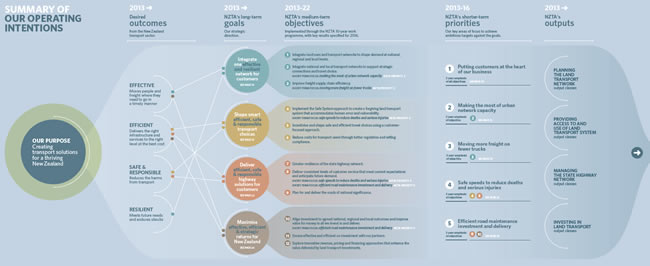 View larger version (PDF, 88 KB)
View larger version (PDF, 88 KB)
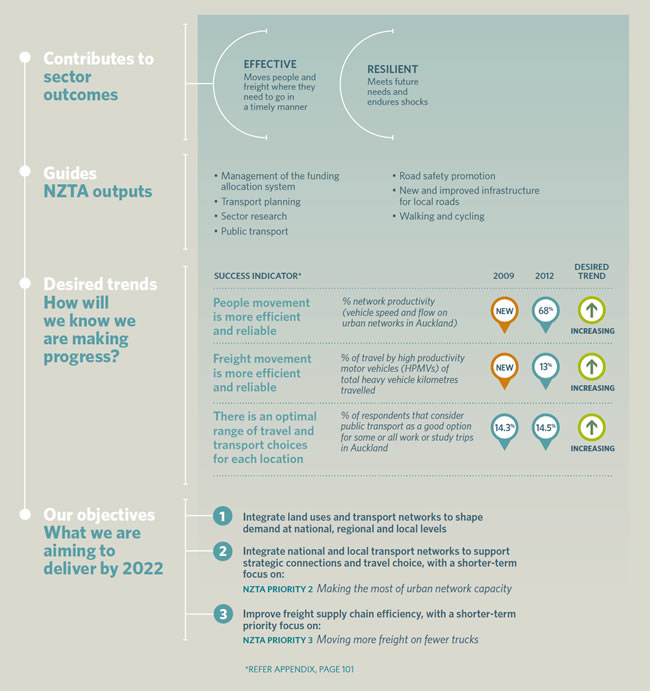 View larger version (JPG, 181 KB)
View larger version (JPG, 181 KB)
New Zealand’s transport network will only be truly effective and resilient when customers experience it as fully integrated across modes and locations, and with the surrounding land uses.
Taking a ‘one network’ approach will help to ensure that the movement of people and freight is efficient and reliable, and that there is an optimal range of travel choices for customers in each location.
Over the next 10 years our work on integrating the network will concentrate on:
We will work with our partners to more closely integrate the national, regional and local networks with their surrounding land uses.
| Results by 2016 | Milestones by 2013/14 |
|---|---|
| Regional land transport and public transport plans are informed by a solid understanding of future demand and make an effective contribution to the development of the 2015–18 NLTP (Note: this is a shared desired result with local government) |
Complete work with the Ministry of Business, Innovation and Employment and the Ministry of Transport on national and regional futures and scenarios and their land transport demand implications (Note: this is a shared milestone) |
| ‘Greenfields’ and ‘brownfields’ land use developments demonstrate improved integration with local and strategic transport networks (Note: this is a shared desired result with local government, who take the lead on land use planning) |
Auckland Council and Auckland Transport ensure that cost effective provision of infrastructure is recognised and facilitated by the Auckland Unitary Plan (Note: this is a shared milestone) We will work effectively with Auckland Council and Auckland Transport on the planning of infrastructure for brownfield and greenfield development and special housing areas identified through the Auckland Housing Accord (Note: this is a shared milestone) We will work with the Canterbury Earthquake Recovery Authority (CERA), Environment Canterbury (ECAN) and Christchurch City Council (CCC) to ensure that cost effective provision of infrastructure is recognised and facilitated by the Christchurch Land Use Recovery Plan (Note: this is a shared milestone) |
We approach the land transport network as one system, regardless of the mode or who manages it. We work with other network operators and stakeholders to ensure seamless integration and management of national and local networks. One area of specific focus is on supporting the growth of Auckland to be one of the most liveable cities in the world. We will work closely with our partners to use new technology, information and incentives to optimise the way that networks are used. Over the next three years this work will focus on making the most of urban network capacity.
| Results by 2016 | Milestones by 2013/14 |
|---|---|
| Priority 2: Making the most of urban network capacity | |
| Network operating plans have been completed for all major urban centres and are being implemented to achieve measurable benefits (Note: this is a shared desired result with these local authorities) |
Network operating plans completed in Auckland, Wellington and Christchurch (including public transport) |
| Transport operations centres in Auckland, Wellington and Christchurch are consolidated and working efficiently (Note: this is a shared desired result with these local authorities) |
Christchurch Transport Operating Centre fully operational Wellington Transport Operating Centre operational between Wellington City Council and NZTA, with all councils committed to join |
| Urban public transport makes a greater contribution to network performance by implementing the public transport reviews that differentiate levels of service and reprioritise public transport resources and investment to where it has greatest impact (Note: this is a shared desired result with regional councils, public transport operators and territorial local authorities) |
Through the implementation of the public transport operating model, public transport activities in Auckland, Wellington and Christchurch are being refocused so that they are making a measurable contribution to improved network capacity utilisation Develop business case for Christchurch transport interchange and key hubs/spokes (Note: this is a shared milestone with CERA, ECAN and CCC) |
| The strategy set out in Auckland’s Integrated Transport Programme is given effect in the 2015–18 NLTP (Note: this is a shared desired result with Auckland Transport) |
Initiate investment conversations with Auckland Transport for the 2015–18 NLTP, and specifically for ‘one network’ transport planning and the programme priorities around the multi-modal east-west corridor, the south-west multi-modal airport rapid transit and the Auckland–Manukau Eastern Transport Initiative |
| The single national road classification is used to develop an integrated level of service framework for the entire New Zealand road network (Note: this is a shared desired result with local government) (refer to NZTA priority 5) |
A national road classification is successfully completed (Note: this is a shared milestone with local government) (refer to NZTA priority 5) |
| Modern, fully integrated ticketing and fares are being implemented in Wellington, Christchurch and main provincial centres (Note: this is a shared desired result with these local authorities) |
Integrated ticketing procurement process commenced in Wellington, and successful implementation of the Auckland Integrated Fare System (Note: this is a shared milestone with local government) |
We'll continue our work with other network operators, our investment partners, freight owners and freight transport operators, to improve the efficiency of freight supply chains. To help grow our economy there will be a particular focus on moving exports more efficiently from places of production to our international gateways. We'll find efficiency opportunities on the road network and also work to ensure the different parts of New Zealand's freight system are better connected. Our work will ensure better coordination across all the modes and ensure land use and network planning are more integrated. Over the next three years our main focus is on moving more freight on fewer trucks.
| Results by 2016 | Milestones by 2013/14 |
|---|---|
| Priority 3: Moving more freight on fewer trucks | |
| Enhanced HPMV strategic route availability, including ‘first-last mile’ access on local roads and 50MAX HPMV access (trucks up to 50 tonnes), delivers tangible productivity gains for operators (Note: this is a shared desired result with local authorities) |
Deliver access to 1500 kilometres on the strategic HPMV freight network 50MAX HPMV network available on 50% of roading network |
| All HPMV permits for approved routes are processed within five working days (Note: this is a shared desired result with local authorities) |
All HPMV permits for state highways are approved within five working days |
| Smarter, more comprehensive, enforcement of illegally overloaded trucks encourages operator uptake of HPMV permits (Note: this is a shared desired result with NZ Police) |
Weigh Right Action Plan completed and agreed with key parties involved |
| The Upper North Island accord is successfully implemented (Note: this is a shared desired result with KiwiRail, local government, port operators and the freight sector) |
Upper North Island freight plan accord is agreed with representatives from across the freight sector (Note: this is a shared milestone) |
| Improve access to markets and productivity for major freight routes through targeted investments that are guided by the Upper North Island, Central and South Island freight plans (Note: this is a shared desired result with KiwiRail, local government, port operators and the freight sector) |
South Island and Central New Zealand freight stories completed National Freight Action Plan agreed with representatives from across the freight sector (Note: this is a shared milestone) |
| Progress improved integration of the road, rail, maritime and air networks to improve the efficiency of freight supply chains (Note: this is a shared desired result with a wide range of transport system organisations and operators) |
Long-term strategic freight network planning proposal developed for KiwiRail/NZTA |
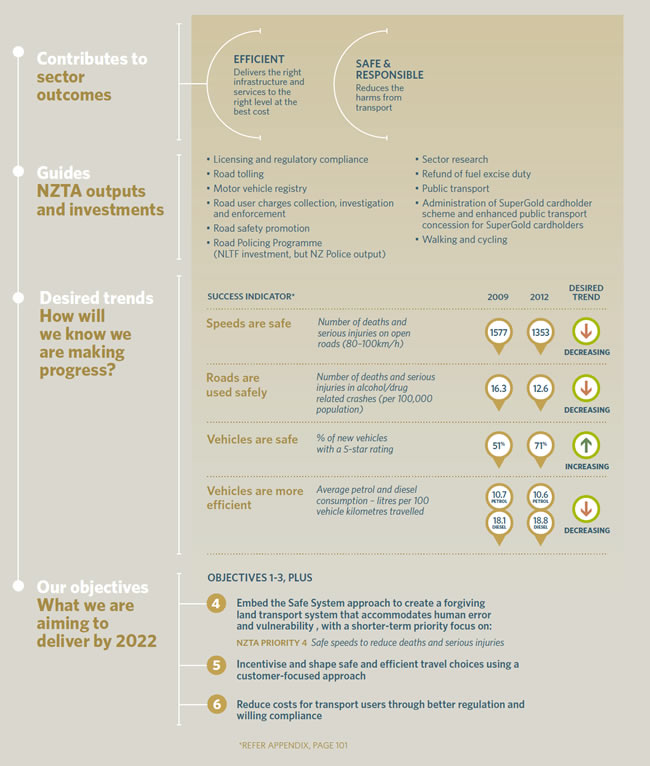 View larger version (JPG, 205 KB)
View larger version (JPG, 205 KB)
Within a transport network that is fully integrated, customers should be able to make really smart choices about their driving, vehicles, routes and timing.
Smart customers will use the entire network safely and efficiently, which includes smart drivers making sure that their speeds are safe. Smart buyers and operators will choose safe, efficient and environmentally responsible vehicles.
Over the next 10 years our work on shaping smart choices, within one integrated network for customers, will concentrate on:
The Safe System approach is at the core of the government’s Safer Journeys road safety strategy to 2020. It recognises that mistakes are inevitable, but deaths and serious injuries from road crashes are not. In a safe system, the performance of roads and roadsides, vehicles, speeds and road use all need to be strengthened to ensure crashes are survivable. We will continue to embed the Safe System approach into our business and across the sector to ensure our decision making frameworks, partnerships with stakeholders and the publicdeliver safe speeds, safe roads and roadsides, safe vehicles and safe people. Over the next three years our priority focus is on safe speeds.
| Results by 2016 | Milestones by 2013/14 |
|---|---|
| Priority 4: Safe speeds to reduce deaths and serious injuries | |
| The new national direction and guidance for speed management in New Zealand is widely supported and adopted by road controlling authorities and key agencies (Note: this is a shared desired result with the Ministry of Transport, NZ Police, local government, ACC and road user groups) |
Develop with road safety partners, a new national direction and guidance on speeds that are right for the road, the vehicle and the environment |
| The New Zealand public is more supportive of a safe system and safe speeds linked to different types of roads, vehicles and environments, as shown in a reduction in mean speeds on high volume undivided open roads (Note: this is a shared desired result with the Ministry of Transport, NZ Police, local government, ACC and road user groups) |
Develop a comprehensive, long-term communication and engagement programme to increase partner, stakeholder and public understanding of, and support for, safe speeds. This will have a strong education focus |
| The national and regional strategic high volume roads that require changes to enable safe speeds are incorporated in the 2015–18 and future NLTPs within the available funding, leading to a sustained increase in the % of national and regional strategic arterials and state highways with a star rating of 3.5 and above | Develop a speed risk management guide to inform speed interventions across all parts of the road safety system and link application of the guide to investment |
| The Safer Journeys 2013–15 Action Plan's ‘signature projects’ successfully demonstrate the value of the Safe System approach to local communities and transport practitioners (Note: this is a shared desired result with the Ministry of Transport, ACC, NZ Police and local government) |
A signature project is successfully launched (Note: this is a shared milestone with ACC, NZ Police and local government) |
| All relevant NZTA staff fully understand and apply the Safe System approach and key NZTA manuals, processes, decision making frameworks and partnerships support the successful implementation of a safe road system in New Zealand | Relevant NZTA staff and leaders trained in the Safe System approach Key NZTA manuals, processes and decision making frameworks reviewed and changed to deliver a safe road system |
| The seven ‘cross sector enabler’ actions in the Safer Journeys Action Plan 2013–15 are successfully implemented (Note: this is a shared desired result with the Ministry of Transport, NZ Police, local government and ACC) |
The remaining actions from the 2011/12 Safer Journeys Action Plan are progressed: ›› Implement revised Road Safety Action Planning approach ›› Complete Coromandel demonstration project and ready Maramarua demonstration project for construction ›› Complete and promulgate High-risk intersection guide ›› Complete motorcycle licence changes, introduce maximum time licence limits, and child restraint age extension |
We will encourage land transport users to make smart choices and adopt best practices in developing driving skills, choosing vehicles and managing commercial drivers. We will look at ways to incentivise users and business to adopt best practices, supported by appropriate regulation, education and information.
| Results by 2016 | Milestones by 2013/14 |
|---|---|
| Transport users in key urban areas can readily access information on safe and efficient travel choices (Note: this is a shared desired result with local government and transport information suppliers) |
Immediate travel time and user information improvement projects are being successfully implemented (Note: this is a shared milestone with local government) |
| Targeted and sustainable initiatives to exit the less-safe vehicles from the fleet are successfully implemented (Note: this is a shared desired result with the Ministry of Transport, NZ Police and ACC) |
Options to encourage less-safe vehicles to exit from the fleet are developed, considered and the action plan agreed (Note: this is a shared milestone with the Ministry of Transport, NZ Police and ACC) |
| Blood alcohol concentration limits reflect risk (Note: this is a shared desired result with the Ministry of Transport and NZ Police) |
The effectiveness of alcohol interlocks is reviewed and recommendations made for their future use (Note: this is a shared milestone with the Ministry of Transport) |
| At least 20 high-risk intersections are improved as per agreed solutions (Note: this is a shared desired result with local government) |
The ‘100 highest-risk intersection’ programme for state highways and local roads is launched and progressed |
We will work with our partners to ensure that complying with regulations is simple and affordable, and to lift behaviour from compliance with the statutory minimum, to best practice. We envisage that the net effect of customers making smarter land transport choices will be a more efficient, effective, responsible and safer land transport network.
| Results by 2016 | Milestones by 2013/14 |
|---|---|
| The land transport regulatory reform programme delivers reduced compliance costs for transport users, as part of the government’s ‘better regulation’ programme (Note: this is a shared desired result with the Ministry of Transport) |
The vehicle licensing reform changes are successfully implemented The 2013/14 Rules Programme is delivered to agreed time, cost and quality standards |
| There is a marked shift of people who meet their obligations for accessing and using the land transport network on time, and who find it easy to do so | Our ‘world class regulator’ business plan is successfully completed, and the structures and resources are set in place and committed to ensure successful realisation |
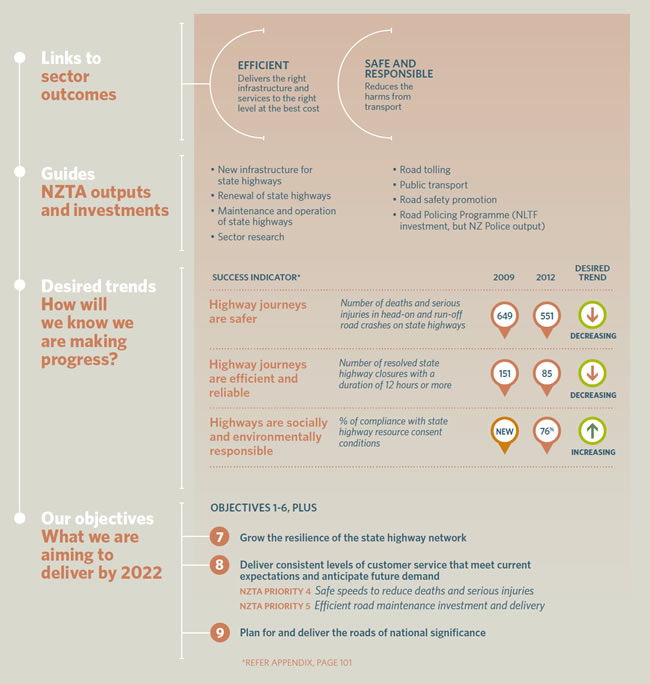 View larger version (JPG, 174 KB)
View larger version (JPG, 174 KB)
State highways are a core element of New Zealand’s integrated land transport network, and we will keep working on solutions that assist customers with making smart choices about routes, timing and driving.
For our customers we aim to offer highway journeys that are safe, efficient and reliable. We also work to ensure that state highways are managed in a socially and environmentally responsible manner.
Over the next 10 years, consistent with the one integrated network and smart choices approach, the state highway component will concentrate on the following customer solutions:
The resilience of the land transport network and its ability to recover from planned and unexpected events and return to providing the required level of service for customers requires careful planning, investment and management. We will improve our understanding of what resilience means in relation to the state highway network and sharpen our investment and planning tools to ensure we have the resources to address it. We will also consider what resilience means in relation to all roading network assets, services, systems and relationships.
| Results by 2016 | Milestones by 2013/14 |
|---|---|
| There is a shared national ‘horizontal infrastructure’ network investment and management approach to resilience (Note: this is a shared desired result with other national network operators and local authorities) |
Operational network resilience policy adopted Business case for national interventions for natural disasters on the State highway network is completed |
| A national resilience identification and prioritising programme, which integrates the state highway and local roading networks, is incorporated into the 2015–18 NLTP | The review of our investment prioritisation framework incorporates the new resilience operating policy |
We will work to anticipate, shape and respond to new demands on state highways so we can achieve and maintain the required levels of service over the next 30 years. This means we need to work closely with a range of stakeholders to understand how changes in freight, business, climate and population might affect the service level required for each category of state highway.
We will identify the gaps between the current and desired levels of service and as a first step we will act to close the most critical gaps. Achieving the desired levels of service will involve the use of a wide range of approaches, including further investment and the use of longer-term transport and land-use planning approaches to influence demand on state highways and neighbouring local roads.
Our desired result is seamless and efficient journeys for our state highways customers and enabling them to move between state highways and local roads, and from vehicles to other modes of land transport (such as walking, cycling and public transport), and to airports and ports safely and efficiently. Over the next three years our particular focus is on safe speeds and road maintenance delivery.
| Results by 2016 | Milestones by 2013/14 |
|---|---|
| Safe speeds reduce deaths and serious injuries (NZTA priority 4) |
Refer to the specific priority deliverables and milestones |
| Efficient road maintenance investment and delivery (NZTA priority 5) |
Refer to the specific priority deliverables and milestones |
| The State Highway Asset Management Plan directs the activity on the network to effectively target customer need, optimise asset management and delivers value for money | The State Highways Asset Management Plan reflects a greed differentiated levels of service and realises the targeted cost efficiencies |
| State highway asset management is refocused on journey time reliability as well as customer service delivery, and achieves a ‘step change’ in the capability of delivery | The first phase of the ‘single supplier’ delivery model for asset management is successfully implemented and the supporting internal restructuring is completed |
The RoNS programme represents one of New Zealand’s biggest ever infrastructure investments, and is a key part of the government’s National Infrastructure Plan (refer to page 9) and the Government Policy Statement on Land Transport Funding (refer to page 9). The six RoNS projects are based around New Zealand's five largest population centres. The focus is on moving people and freight between and within these centres more safely and efficiently.
The programme commenced in 2009, and one of the original seven projects (Victoria Park tunnel in Auckland) opened in 2012.
| Road of national significance | Milestones by 2013/14 | Milestones by 2014/15 | Milestones by 2015/16 |
|---|---|---|---|
| Puhoi to Wellsford | Puhoi to Warkworth in development | Puhoi to Warkworth in development | Puhoi to Warkworth in development |
| Western Ring Route (WRR) | WRR under construction including Waterview and Causeway | WRR under construction including Waterview and Causeway | WRR under construction including Waterview and Causeway |
| Waikato Expressway | Under construction: Rangiriri and Cambridge Ngaruawahia open |
Under construction: Cambridge Rangiriri open |
Under construction: Huntly, Hamilton and Cambridge |
| Tauranga Eastern Link | Under construction | Under construction | Under construction |
| Wellington Northern Corridor | Under construction: MacKays to Peka Peka; Transmission Gully enabling and procurement In design: Basin Reserve improvements; Peka Peka to Otaki |
Under construction: MacKays to Peka Peka; Transmission Gully; Basin Reserve improvements; In design: Peka Peka to Otaki; Airport to Mt. Victoria Tunnel |
Under construction: MacKays to Peka Peka; Transmission Gully; Basin Reserve improvements In design: Peka Peka to Otaki; Airport to Mt. Victoria Tunnel |
| Buckle Street | Under construction | Open | - |
| Christchurch Motorways | |||
| Christchurch Southern Motorway | Stage 2 in design | Stage 2 in design | Stage 2 under construction |
| Western Corridor | Under construction: Harewood Road to Yaldhurst Road four-laning; Sawyers Arms to Wairakei (Harewood) Road four-laning In design: Groynes to Sawyers Arms four-laning; Western Belfast Bypass |
Under construction: Groynes to Sawyers Arms four-laning; Harewood Road to Yaldhurst Road four-laning Complete: Sawyers Arms to Wairakei (Harewood) Road four-laning |
Under construction: Western Belfast Bypass; Groynes to Sawyers Arms four-laning; Harewood Road to Yaldhurst Road four-laning |
Note: These milestones reflect the forecast from the NLTF, but rely on the revenue from fuel excise duty and road user charges, which are both dependent on volume. Any changes to available funding may result in retiming of the milestones.
 View larger version (JPG, 187 KB)
View larger version (JPG, 187 KB)
Transport networks require ongoing investment in renewals, maintenance, operations and enhancements in order to remain effective, efficient, safe and resilient.
The National Land Transport Fund is the most significant source of investment in land transport networks and services, and our task is to ensure that this investment delivers the maximum possible returns to transport users and a thriving New Zealand.
As we develop and fund the National Land Transport Programme and Road Policing Programme, we will remain focused on:
We will work with our co-investment partners to develop and implement National Land Transport Programmes that maximise returns against the impacts sought by central and local government. We will seek to realise these outcomes through a planning and investing for outcomes business model. Our value for money investment focus emphasises the need for integrated planning, partnering for investment and enhancing investment performance.
Over the next three years our particular value for money focus is on road maintenance investment and delivery.
| Results by 2016 | Milestones by 2013/14 |
|---|---|
| Priority 5: Efficient road maintenance investment and delivery | |
| All roads are differentiated by form and type to allow national consistency in investment priorities, in all work programmes in the NLTP | Develop a one network classification tool and determine associated levels of service Align the understanding of the one network classification system with RCA partners and its use in investment decisions Alignment on the Investment process |
| Collaboration and information sharing increases between all road controlling authorities (RCAs) | Conversations with and between all RCAs and business cases for the 4–5 early adopters |
| Asset management plans (AMPs) are developed and implemented consistently throughout New Zealand | Differences in AMPs identified and remedial measures explored |
| Asset management planning and procurement policy and guidance is aligned to promote value for money | Streamlined procurement practices in place The long-term programme of investment is clarified |
| The 2012–15 NLTP is successfully delivered using quality procurement approaches | Adjust 2012–15 NLTP investment to match revenue to deliver maximum returns |
| The recovery of Canterbury's transport networks will be substantially complete and the NLTP contributions to Canterbury’s recovery will achieve best value for money delivery according to programme (Note: this is a shared desired result with other central government agencies, local authorities and contractors) |
Deliver Stronger Christchurch Infrastructure Rebuild Team (SCIRT) value and report (Note: this is a shared milestone with CERA and CCC) Complete the prioritised 2013/14 Canterbury rebuild work programme on time and within budget (Note: this is a shared milestone with CERA, SCIRT and CCC) |
| Further versions of the Auckland Integrated Transport Programme incorporate the aligned funding pathways for Auckland and reflects the shared future direction for transport in the city (Note: this is a shared desired result with Auckland Council, Auckland Transport and the Ministry of Transport) |
Contribute to the completion of the second version of the Auckland Integrated Transport Programme |
| The 2015–18 GPS provides effective guidance for NLTF investment (Note: the GPS is a Ministry of Transport responsibility) |
We provide effective support to the development of the 2015–18 GPS, drawing on lessons learnt from the 2012–15 NLTP development and delivery |
We will apply the value for money assessments of cost-efficiency and cost-effectiveness to proposed land transport investments we make with our partners. This ensures that we are co-investing in the right things in the right ways at the right time at the right price. Following this investment discipline means that we have a National Land Transport Programme that maximises net national benefit and delivers transport solutions that support a thriving New Zealand.
| Results by 2016 | Milestones by 2013/14 |
|---|---|
| The reviewed funding assistance rate system is implemented in the 2015–18 NLTP | Complete the review of the funding assistance rate system |
| The 2015–18 NLTP is developed using a ‘planning and investment for outcomes’ approach that maximises returns on NLTF investment by increasing the focus on benefit optimisation and realisation | Ongoing implementation of the planning and investing for outcomes approach via an integrated focused programme of work Identify and document key national and regional network issues Improved critical tools, processes and systems, including (but not limited to) assessment framework, business case approach, benefits realisation model, shared evidence base and review of the Economic evaluation manual |
| Effective public transport network design and management delivers progressively increased returns per NLTF $ invested (Note: this is a shared desired result with regional councils, local authorities and public transport operators) |
Implementation of the public transport operating model is progressing to plan in major urban areas as networks are reviewed and new contracts established with service operators (Note: this is a shared milestone with local government) |
We will support the Ministry of Transport to investigate additional mechanisms for raising revenue for land transport investments. This should include financing options that supplement the current ‘pay as you go’ system.
| Results by 2016 | Milestones by 2013/14 |
|---|---|
| The NZTA’s tolling and public private partnership (PPP) policies are successfully applied to new state highway road development where appropriate | Develop and assess procurement of Transmission Gully as a PPP Assess business case for procurement of Puhoi to Wellsford as a PPP |
| Previous page | Table of contents | Next page |